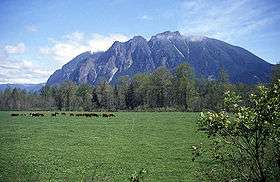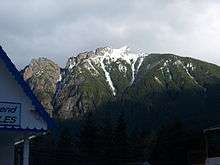Mount Si
| Mount Si | |
|---|---|
 Mount Si from the southwest | |
| Highest point | |
| Elevation | 4,167 ft (1,270 m) NGVD 29[1] |
| Prominence | 247 ft (75 m) [1] |
| Coordinates | 47°30′27″N 121°44′24″W / 47.5076029°N 121.7401092°WCoordinates: 47°30′27″N 121°44′24″W / 47.5076029°N 121.7401092°W [2] |
| Geography | |
 Mount Si | |
| Parent range | Cascades |
| Topo map | USGS Mount Si |
| Climbing | |
| Easiest route | Hike and short class 3, scramble |
Mount Si (pronounced sigh) is a mountain in the U.S. state of Washington. It lies on the western margin of the Cascade Range just above the coastal plains around Puget Sound, and towers over the nearby town of North Bend. The mountain was named after local homesteader Josiah "Uncle Si" Merritt. It was made famous in the show Twin Peaks, which was filmed in North Bend.
Only about a 45-minute drive from Seattle, the mountain is a favorite outdoor destination for residents of Puget Sound. Between 80,000 and 100,000 hikers visit the mountain annually.[1] The land is owned by the state of Washington and has been designated a Natural Resources Conservation Area.
The 4-mile (6.4 km) long Mount Si trail climbs a total of 3,500 feet (1,100 m) reach to the summit ridge.[1] The summit of Mount Si can then be reached by an exposed scramble, class 3, up the north side of the summit block which is known as the "Haystack."[3]
Oceanic Plate Volcano

Mount Si is a remnant of an oceanic plate volcano and the rocks are highly metamorphosed.[4]
In local native legend
Mount Si figures prominently in a Prometheus story from the Snoqualmie tribe. According to the story it is the dead body of Snoqualm, the moon. Snoqualm had ordered that a rope of cedar bark be stretched between the earth and the sky. But Fox and Blue Jay went up the rope and stole the sun from Snoqualm. Snoqualm chased them down the cedar rope, but it broke and he fell to his death. Fox then let the sun free in the sky and gave fire to the people. A face like Snoqualm's is visible on the rocks near the summit.[5]
See also
References
- 1 2 3 4 "Mount Si, Washington". Peakbagger.com.
- ↑ "Mount Si". Geographic Names Information System. United States Geological Survey.
- ↑ "Mount Si". SummitPost.org. Retrieved 2011-05-07.
- ↑ "Mount Si Natural Resources Conservation Area (NRCA)". SummitPost.org. Retrieved 2011-05-07.
- ↑ Costello, J.A. (1895). The Siwash: their life, legends and tales. Seattle: Calvert. pp. 75–76. OCLC 228721459.
- Beckey, Fred W. (2000). Cascade Alpine Guide, Vol. 1, Columbia River to Stevens Pass (3rd ed.). Mountaineers Books. p. 151. ISBN 0-89886-577-8.
- Spring, Ira; Harvey Manning (1983). 102 Hikes in the Alpine Lakes, South Cascades, and Olympics (3rd ed.). Seattle: Mountaineers Books. ISBN 0-89886-067-9.
External links
| Wikimedia Commons has media related to Mount Si. |
- "Mount Si Web Site" (web). MountSi.com.
- "Mount Si NRCA and Upper Snoqualmie Valley" (map). Washington State Department of Natural Resources.
- "Mount Si Brochure" (PDF). Washington State Department of Public Resources. Archived from the original (PDF) on 2007-07-15. Retrieved 2010-03-13.
- View of Mount Si from I-90 on Google Street View
